Avete intenzione di spostare il vostro sito WordPress su una nuova società di hosting o su un altro server? È una decisione importante e, comprensibilmente, probabilmente siete preoccupati per la potenziale perdita di dati e per i tempi di inattività.
Secondo la nostra esperienza, questi sono sicuramente i rischi maggiori quando si cambia hosting o si migra un sito web. Tuttavia, si può tranquillamente passare a un nuovo host o server senza compromettere l’esperienza dell’utente o il tempo di attività.
Infatti, abbiamo cambiato il sito WPBeginner da HostGator a SiteGround nel 2020. Quindi, abbiamo affrontato con successo questo processo senza impattare negativamente sui nostri lettori.
In questo tutorial passo dopo passo, vi mostreremo come migrare in modo sicuro il vostro sito WordPress su un nuovo host senza alcun tempo di inattività. Risponderemo anche alle domande più frequenti sul trasferimento di un sito WordPress a un nuovo provider di hosting.
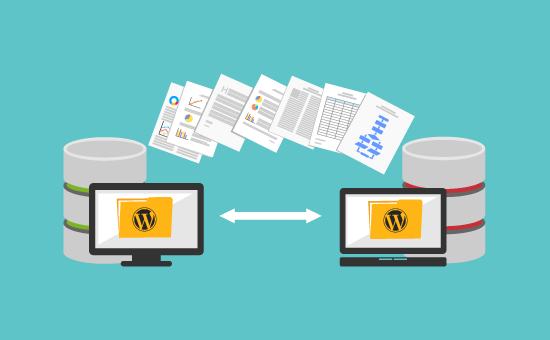
Importante: prima di iniziare, vogliamo farvi sapere che molte società di hosting WordPress offrono un servizio di migrazione gratuito. Potrebbe non essere indicato sul loro sito web, quindi non dovete fare altro che chiedere. Di solito è gratuito, ma alcuni potrebbero richiedere un piccolo contributo.
Detto questo, vediamo i passaggi da seguire per spostare WordPress su un nuovo server di hosting (senza tempi di inattività):
Pronti? Iniziamo.
Passo 1: Scegliere il nuovo host WordPress
Se siete bloccati con un host web lento anche dopo aver ottimizzato la velocità e le prestazioni di WordPress, allora è il momento di spostare il vostro sito WordPress su un nuovo host in grado di gestire il vostro traffico crescente.
Quando si cerca un nuovo provider di hosting WordPress, è importante scegliere con cura per non dover cambiare di nuovo fornitore in tempi brevi.
Ecco chi raccomandiamo:
- Per un hosting condiviso affidabile, consigliamo di scegliere Bluehost. È ufficialmente raccomandato da WordPress.org. Utilizzando il nostro coupon Bluehost, gli utenti di WPBeginner possono usufruire di uno sconto fino al 75% e di un nome di dominio gratuito.
- Per un hosting condiviso più veloce, consigliamo Hostinger. È una delle migliori società di hosting WordPress e offre server più veloci con un’assistenza clienti eccezionale.
- Se siete alla ricerca di hosting cloud o di provider specifici per una determinata località, vi consigliamo di dare un’occhiata a SiteGround. Dispone di centri dati in tre diversi continenti.
- Se state cercando un hosting WordPress gestito, vi consigliamo di dare un’occhiata a WP Engine. È il fornitore migliore e più conosciuto del settore.
Dopo aver acquistato il nuovo hosting, NON installate WordPress. Lo faremo in una fase successiva.
Per il momento, il nuovo account di web hosting dovrebbe essere vuoto, senza file o cartelle nella directory principale.
Fase 2: Impostazione di Duplicator per una facile migrazione
La prima cosa da fare è installare e attivare il plugin Duplicator sul sito web che si desidera spostare. Per maggiori dettagli, consultate la nostra guida passo passo su come installare un plugin di WordPress.
Duplicator è il miglior plugin per la migrazione di WordPress sul mercato. È dotato di backup automatici programmati, supporto per il cloud storage, ripristino in un clic e migrazioni intelligenti.
Nota: Duplicator ha anche una versione gratuita chiamata Duplicator Lite. Può essere utilizzata per spostare il vostro sito web, ma ha funzioni limitate rispetto alla versione pro.
Una volta installato e attivato Duplicator, andare alla pagina Duplicator ” Backups nell’area di amministrazione di WordPress.
Successivamente, è necessario fare clic sul pulsante “Aggiungi nuovo” nell’angolo in alto a sinistra.
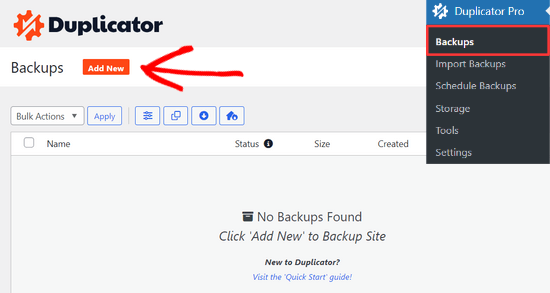
In questo modo si avvia la procedura guidata di backup di Duplicator.
Nella schermata successiva, è possibile inserire un nome per il backup oppure utilizzare i tag dinamici per creare automaticamente un formato di nome, come la data e il titolo del sito.

Quindi, è possibile espandere la sezione “Archiviazione” per selezionare una posizione di archiviazione. Per questa esercitazione utilizzeremo la posizione predefinita, ma è possibile aggiungere una nuova posizione, come Dropbox o Google Drive, facendo clic sul link “Aggiungi archiviazione”.
È sufficiente fare clic sul pulsante “Avanti” per continuare.
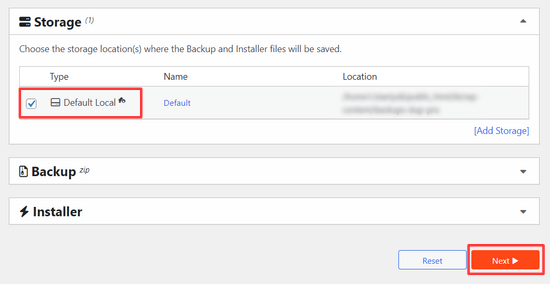
Successivamente, Duplicator scansiona il sistema per assicurarsi che tutto sia in ordine per preparare il pacchetto.
Assicuratevi che i risultati della scansione siano verificati (tutto dovrebbe essere “Buono”), quindi fate clic sul pulsante “Crea backup”.
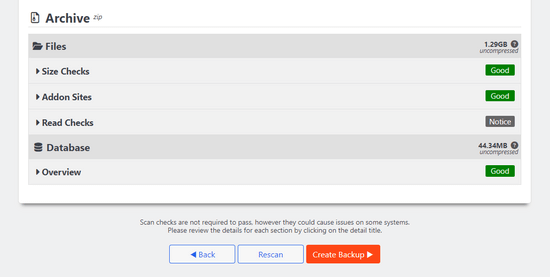
Il processo potrebbe richiedere alcuni minuti, quindi lasciate la scheda aperta mentre il plugin svolge il suo lavoro.
Una volta completato il processo, verranno visualizzate le opzioni di download per il programma di installazione e per l’archivio. È necessario fare clic sul pulsante “Download” e selezionare l’opzione “Entrambi i file”.
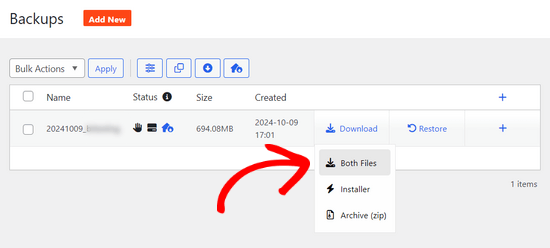
Il file di archivio è una copia del vostro sito web completo, mentre il file di installazione automatizza il processo di installazione.
Passo 3: Importare il sito WordPress nel nuovo host
Dopo aver scaricato i file dell’archivio e del programma di installazione, il passo successivo è caricarli sul nuovo host web.
È possibile farlo collegandosi al nuovo host Web tramite FTP.
Se non l’avete mai fatto prima, date un’occhiata alla nostra guida per principianti sul caricamento di file via FTP su WordPress.
Normalmente, quando si collega il client FTP, si inserisce il nome di dominio del sito web come host.
Tuttavia, poiché il nome di dominio punta ancora al vecchio host, è necessario connettersi inserendo l’indirizzo IP o il nome host del server.
Potete trovare queste informazioni nella dashboard del pannello di controllo del vostro nuovo account di hosting.
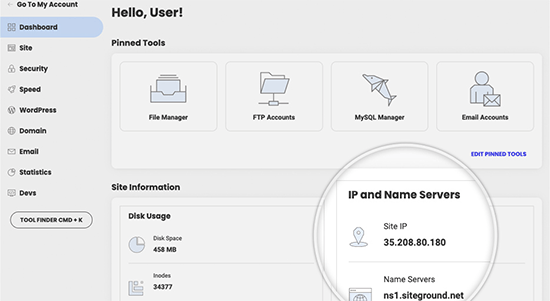
Se non riuscite a trovare queste informazioni, potete chiedere assistenza alla vostra nuova società di web hosting, che vi aiuterà.
Utilizzando il client FTP, è necessario caricare sia il file installer.php sia il file .zip dell’archivio nella directory principale del sito web.
Di solito si tratta della cartella /username/public_html/.
Anche in questo caso, se non siete sicuri, chiedete alla vostra società di web hosting.
Assicuratevi che la vostra directory principale sia completamente vuota. Alcune società di web hosting installano automaticamente WordPress al momento dell’iscrizione.
Se WordPress è installato nella directory principale, è necessario prima eliminare WordPress.
Una volta fatto ciò, è necessario caricare sia il file zip dell’archivio sia il file installer.php nella directory principale del sito.
Passo 4: modificare il file Hosts per prevenire i tempi di inattività
Una volta caricati entrambi i file sul nuovo host, è necessario accedere al file installer.php in un browser.
Normalmente, si può accedere a questo file utilizzando un URL come questo:
http://www.example.com/installer.php
Tuttavia, questo URL vi porterà al vostro vecchio host web e riceverete un errore 404. Questo perché il nome di dominio punta ancora al vecchio host web.
Normalmente, altri tutorial potrebbero dirvi di cambiare il nameserver del vostro dominio e farlo puntare alla nuova società di hosting, ma è sbagliato.
Se lo fate ora, i vostri visitatori vedranno un sito web non funzionante durante la migrazione.
Vi mostreremo come potete accedere temporaneamente al vostro nuovo sito sul vostro computer senza influenzare il vostro vecchio sito.
Questo viene fatto con il file hosts del computer.
Il file hosts può essere utilizzato per mappare i nomi di dominio a indirizzi IP specifici. In altre parole, consente di ingannare il computer facendogli credere che il sito web sia spostato anche se non lo è.
Vediamo come aggiungere una voce per il vostro nome di dominio nel file hosts in modo che punti alla vostra nuova società di hosting.
Queste modifiche vi permetteranno di accedere ai file sul nuovo host utilizzando il vostro nome di dominio, mentre il resto del mondo continuerà ad accedere al vostro sito dal vecchio host. Questo garantisce il 100% di uptime.
La prima cosa da fare è trovare l’indirizzo IP del vostro nuovo server di web hosting.
Per trovarlo, è necessario accedere alla dashboard di cPanel e fare clic sul link Espandi statistiche nella barra laterale di sinistra. L’indirizzo del vostro server sarà elencato come “Indirizzo IP condiviso”.
Ad esempio, su Hostinger, troverete l’indirizzo IP del vostro server sotto i dettagli del vostro piano di hosting.
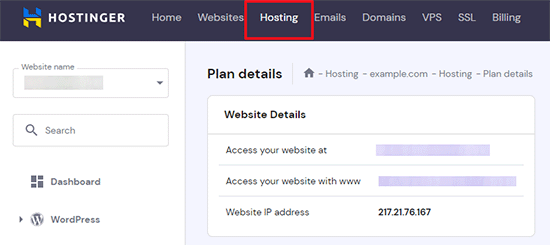
Se si utilizza un PC Windows, è necessario aprire l’applicazione Blocco note con i privilegi di amministratore.
È sufficiente fare clic sul pulsante “Start” e cercare l’applicazione Notepad. Fare clic con il tasto destro del mouse sull’icona del Blocco note e selezionare “Esegui come amministratore”.
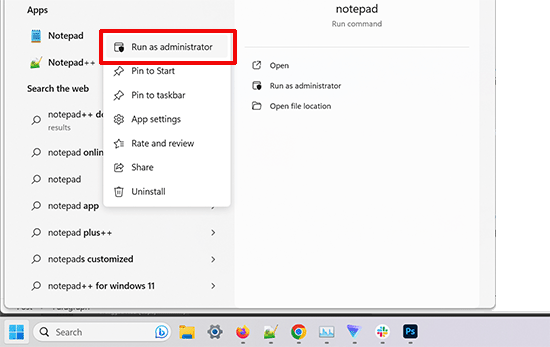
Verrà visualizzato un prompt UAC di Windows e sarà necessario fare clic su “Sì” per avviare Notepad con i privilegi di amministratore.
Nella schermata del Blocco note, andare su File ” Apri e spostarsi nella cartella C:\Windows\System32\drivers\etc. Da questa cartella, selezionare il file hosts e aprirlo.
Se si utilizza un Mac, è necessario aprire l’applicazione Terminale e inserire questo comando per modificare il file hosts:
sudo nano /private/etc/hosts
Sia per gli utenti Windows che per quelli Mac, nella parte inferiore del file hosts è necessario inserire l’indirizzo IP copiato e poi il nome del dominio. In questo modo:
192.168.1.22 www.example.com
Assicuratevi di sostituire l’indirizzo IP con quello copiato da cPanel e example.com con il vostro nome di dominio.
Al termine, salvare le modifiche.
Ora è possibile accedere ai propri file sul nuovo host utilizzando il nome di dominio sul proprio computer.
Importante: Non dimenticate di annullare le modifiche apportate al file hosts al termine della migrazione (passaggio 6).
Passo 5: Creare il database MySQL sul nuovo host
Prima di eseguire il programma di installazione sul nuovo host, è necessario creare un database MySQL sul nuovo account di hosting. Se avete già creato un database MySQL, potete passare al passo successivo.
Creare un database in cPanel
Accedete al cruscotto del vostro nuovo account di hosting, scorrete fino alla sezione Database e fate clic sull’icona “Database MySQL”.
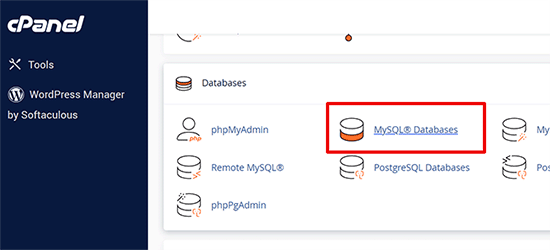
Verrà visualizzato un campo per la creazione di un nuovo database.
Inserite un nome per il vostro database e fate clic sul pulsante “Crea database”.

Dopo aver creato il database MySQL, è necessario scorrere verso il basso fino alla sezione Utenti MySQL.
Quindi, fornire un nome utente e una password per il nuovo utente e fare clic sul pulsante “Crea utente”.
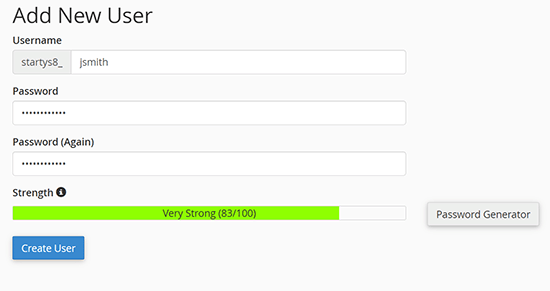
Successivamente, è necessario aggiungere questo utente al database. Questo darà al nome utente appena creato tutti i permessi per lavorare su quel database.
È possibile farlo scorrendo verso il basso fino alla sezione “Aggiungi utente a un database”. È sufficiente selezionare l’utente del database creato dal menu a discesa accanto all’utente, quindi selezionare il database e fare clic sul pulsante “Aggiungi”.
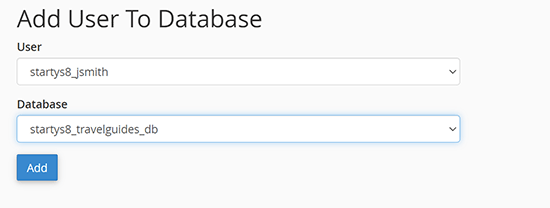
Il database è ora pronto per essere utilizzato con WordPress. Assicuratevi di annotare il nome del database, il nome utente e la password. Queste informazioni vi serviranno nella fase successiva.
Fase 6: avvio del processo di migrazione del Duplicatore
Ora siamo pronti a eseguire il programma di installazione. Navigate al seguente indirizzo nella finestra del browser, sostituendo example.com con il nome del vostro dominio:
http://www.example.com/installer.php
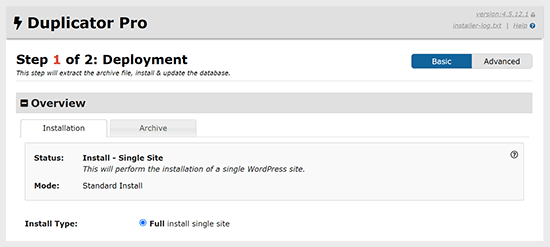
Il programma di installazione eseguirà alcuni test e mostrerà “Pass” accanto ai test di archivio e di convalida.
È necessario selezionare la casella di controllo dei termini e delle condizioni e continuare facendo clic sul pulsante “Avanti”.
A questo punto, vi verrà chiesto di inserire l’host MySQL, il nome del database, il nome utente e la password.
L’host sarà probabilmente localhost. Dopodiché, si inseriranno i dettagli del database creato nel passaggio precedente.
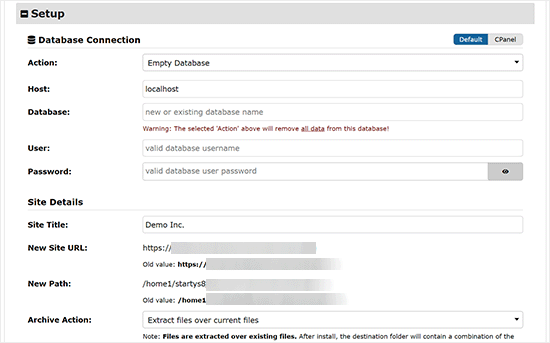
Successivamente, il Duplicatore deve verificare di potersi connettere al database e di poter eseguire l’installazione.
Fare clic sul pulsante “Convalida” in basso per continuare.

Se Duplicator riesce a connettersi, i risultati del test vengono visualizzati come Pass.
A questo punto è possibile selezionare la casella di controllo dei termini e delle avvertenze e fare clic sul pulsante “Avanti”.
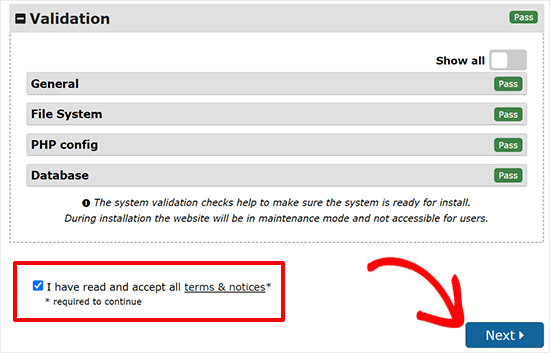
Fare clic sul pulsante “Avanti” per continuare.
Duplicator importerà ora il database di WordPress dallo zip dell’archivio nel nuovo database.
Successivamente, verrà richiesto di aggiornare l’URL o il percorso del sito. Poiché non si cambiano i nomi di dominio, NON è necessario modificare nulla in questo punto.
È sufficiente fare clic sul pulsante “Avanti” per continuare.
Duplicator eseguirà i passaggi finali e mostrerà il pulsante di accesso.
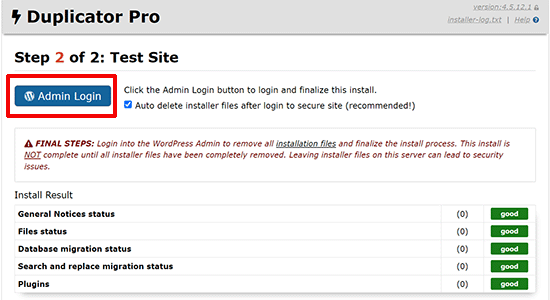
Ora potete accedere al vostro sito WordPress sul nuovo host per verificare che tutto funzioni come previsto.
Passo 7: aggiornare i server dei nomi di dominio (DNS)
A questo punto, avete creato una copia completa del database e dei file di WordPress sul nuovo server di hosting, ma il vostro dominio punta ancora al vecchio account di web hosting.
Per aggiornare il dominio, è necessario cambiare i server dei nomi DNS. In questo modo si garantisce che gli utenti vengano indirizzati alla nuova posizione del sito web quando digitano il dominio nel loro browser.
Se avete registrato il dominio con il vostro provider di hosting, è meglio trasferire il dominio a un nuovo host.
D’altra parte, se si utilizza una società di registrazione di domini come Domain.com, GoDaddy o Network Solutions, è necessario aggiornare i server dei nomi.
Sono necessarie le informazioni sul server dei nomi DNS del nuovo host Web. Di solito si tratta di un paio di URL che assomigliano a questo:
ns1.hostname.comns2.hostname.com
In questa guida vi mostreremo come cambiare i server DNS con GoDaddy.
Per altri provider di hosting, date un’occhiata alla nostra guida sulla modifica dei nameserver dei domini.
A seconda della società di registrazione del dominio o dell’host Web, le schermate possono apparire diverse. Tuttavia, il concetto di base è lo stesso.
Dovete cercare l’area di gestione del dominio e poi cercare i server dei nomi. Se avete bisogno di assistenza per aggiornare i server dei nomi, potete chiedere alla vostra società di web hosting.
Per GoDaddy, è necessario accedere al proprio account GoDaddy e fare clic su “Domini”.
Successivamente, è necessario fare clic sul pulsante “Gestisci” accanto al nome di dominio che si desidera modificare.

Andare alla sezione “Impostazioni aggiuntive”.
Quindi, dovrete cliccare su “Gestisci DNS” per continuare.
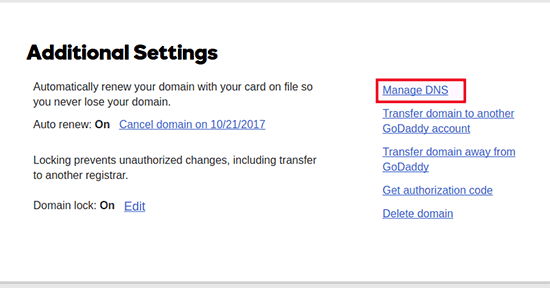
Successivamente, è necessario scorrere verso il basso fino alla sezione “Nameservers”.
Qui, fare clic sul pulsante “Modifica”.
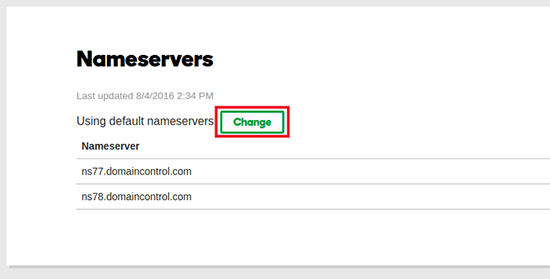
Innanzitutto, è necessario cambiare il menu a tendina del tipo di server dei nomi da “Predefinito” a “Personalizzato”.
Successivamente, è possibile inserire le informazioni del nuovo provider di hosting alla voce Nameservers.
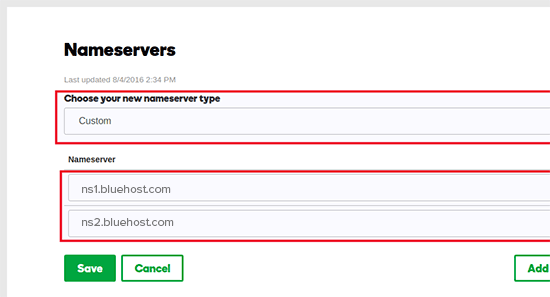
Non dimenticate di fare clic sul pulsante “Salva” per memorizzare le modifiche.
La modifica dei nameserver del vostro dominio è stata effettuata con successo. Le modifiche DNS possono richiedere dalle 4 alle 48 ore per essere propagate a tutti gli utenti.
Poiché i contenuti sono gli stessi sul vecchio e sul nuovo host, i vostri utenti non noteranno alcuna differenza. La migrazione di WordPress avverrà senza soluzione di continuità e senza tempi di inattività.
Per sicurezza, vi consigliamo di aspettare a cancellare il vecchio account di hosting fino a 7 giorni dopo la migrazione.
Domande frequenti
Ecco alcune domande che molti dei nostri utenti ci pongono durante il trasferimento di WordPress da un host all’altro.
1. Come faccio a migrare il mio sito web WordPress su un altro host?
Potete migrare il vostro sito web WordPress spostando i file e il database di WordPress dal vecchio host al nuovo provider di hosting.
Alcune società di hosting offrono anche servizi gratuiti di trasferimento di siti web, ma è necessario chiedere a loro. In alternativa, potete farlo voi stessi trasferendo i file con un client FTP e importando il database tramite phpMyAdmin.
2. Posso migrare il mio sito WordPress su un altro provider di hosting?
Sì, siete liberi di migrare il vostro sito WordPress su un altro provider di hosting.
3. Posso iscrivermi al nuovo account di hosting senza registrare un nome di dominio?
Sì, è assolutamente possibile sottoscrivere un account di hosting senza registrare un nome di dominio.
Il nome di dominio e l’hosting sono due servizi diversi e non è necessariamente necessario registrare un nome di dominio quando ci si iscrive a un nuovo host. Per maggiori dettagli, consultate la nostra guida sulla differenza tra nome di dominio e hosting web.
Alcuni provider di hosting vi chiederanno di selezionare un nome di dominio come primo passo per l’acquisto dell’hosting. Inoltre, vi permetteranno di inserire un nome di dominio se ne avete già uno.
4. Devo trasferire il mio nome di dominio al nuovo host?
No, non è necessario trasferire il nome di dominio al nuovo host. Tuttavia, trasferendo il nome di dominio sul nuovo hosting sarà più facile rinnovarlo e gestirlo sotto la stessa dashboard del nuovo account di hosting.
Per saperne di più su questo argomento, consultate la nostra guida definitiva sui nomi di dominio e sul loro funzionamento.
5. Come si risolve l’errore di connessione al database in Duplicator?
Se viene visualizzato un errore di connessione al database o un errore di connessione al database in Duplicator, è probabile che siano state inserite informazioni errate per la connessione al database.
Assicuratevi che il nome del database, il nome utente MySQL e la password siano corretti. Alcune società di web hosting non utilizzano localhost come host per i loro server MySQL. In questo caso, dovrete chiedere al personale di supporto del vostro host web di fornirvi le informazioni corrette.
6. Come posso verificare se il mio sito web viene caricato dal nuovo host?
Esistono diversi strumenti online che consentono di vedere chi ospita un sito web. Dopo aver trasferito il vostro sito web sul nuovo host, potete utilizzare uno di questi strumenti che vi mostreranno il nome della società di hosting web che ospita il vostro sito.
Se non è passato molto tempo da quando avete migrato il vostro sito web e avete apportato modifiche al server dei nomi di dominio (DNS), è probabile che il vostro sito sia ancora caricato dal vecchio host. Le modifiche al nome di dominio possono richiedere fino a 48 ore per propagarsi completamente.
7. È necessario eliminare i file o i dati dal vecchio host?
Quando si cambia società di hosting, si consiglia di conservare il vecchio sito web per almeno una settimana. Dopodiché, è possibile eliminare i file dal vecchio host web. Se state cancellando il vostro account, il vostro provider di web hosting cancellerà tutti i vostri dati in base alla sua politica.
8. Per quanto tempo devo mantenere attivo il mio account sul vecchio host?
Una volta migrato il vostro sito web sul nuovo host e se non avete altri siti web ospitati presso il vostro vecchio host, potete cancellare il vostro vecchio account di web hosting.
Tuttavia, in alcuni casi, potreste aver già pagato per l’hosting annuale. Dovreste controllare la loro politica di rimborso per vedere se avete diritto a un rimborso in caso di cancellazione.
9. Come faccio a spostare un sito WordPress con SSL/HTTPS?
È necessario installare un certificato SSL sul nuovo provider di hosting. Dopodiché, si possono seguire gli stessi passi indicati sopra. Assicuratevi solo di utilizzare l’HTTPS negli URL, come https://example.com.
10. Bonus: Migrazione gratuita del sito da parte del nuovo host
Se state cercando di cambiare il vostro hosting web, ma i passaggi sopra descritti vi sembrano troppo complicati, potete scegliere i seguenti provider, che migreranno il vostro sito web per voi.
SiteGround, Hostinger e WP Engine offrono la migrazione gratuita del sito web per gli utenti di WPBeginner.
Ci auguriamo che questo tutorial vi abbia aiutato a spostare WordPress sul vostro nuovo host senza alcun tempo di inattività. Se doveste riscontrare dei problemi durante la migrazione di WordPress, vi consigliamo di consultare la nostra selezione dei migliori hosting WordPress economici o la nostra guida sugli errori più comuni di WordPress e su come risolverli.
Se questo articolo vi è piaciuto, iscrivetevi al nostro canale YouTube per le esercitazioni video su WordPress. Potete trovarci anche su Twitter e Facebook.





Shane
In the next step, Windows users need to go to Programs » All Programs » Accessories, right click on Notepad and select Run as Administrator. A Windows UAC prompt will appear, and you need to click on Yes to launch Notepad with administrator privileges.
On the Notepad screen, go to File » Open and then go to C:\Windows\System32\drivers\etc. Select hosts file and open it.
I’m having trouble with this step. Can anyone shed any light?
WPBeginner Support
Hi Shane,
You just need to open the Notepad app as an administrator so that you can edit the hosts file.
Admin
Shane
Oh, just microfosft simple wordpad and then “run as administrator”?
Is that all I have to do?
Muhammed Shabeer
Thanks for the wonderfull trick. Exactly the trick was intented to migrate WordPress to new host, but I used for migrating from root to subdomain/subfolder. It done successfully with the plugin. Thank for sharing the trick.
Kenneth Aycox
Thank you for a wonderful product! worked perfect.
James Crow
Briliiant! Thanks so much, I’ve just moved a few sites without any problem at all.
Max
Sadly, this didn’t work for me either. I deleted all the website files as directed , uploaded to the installer.php file and package but when I went to website.com/installer.php I was served a 404 error: Not Found
The requested URL /installer.php was not found on this server.
I think it’s easier to just transfer the website the old fashioned way, as others have mentioned. No need for any scripts that might not work.
Max
Please disregard my comment. I later noticed the root folder was set to httpdocs. So created a folder, named it httpdocs and put the package and installer.php in there. Then the website.com/installer.php worked no problem. All went very smoothly thereafter.
Nandan Jha
Hello Max,
Actually it did work for me in the end. I am guessing that you moved the installer and archive to your new host , correct ?
Please look up the IP address from cpanel or equiv of the new host and try accessing via the IP address
http://IPAddress/installer.phpKB
Seems like a good tutorial, but I had no luck with it. There are also a few steps/screens in the Duplicator sequence that were different from mine. The end result was, I got a 404 error upon clicking Site Login – Login to finalize the setup in Step 4 of 4 of the Test Site screen. This differs substantially from the above. Top right corner there’s a version number of 1.2.30. Fairly certain I have the most up to date version of the plugin. If I use File Manager to view the contents of public_html I don’t see the normal list of wp files that I think I should see aside from a wp-snapshots directory, a few web.config files, some installer files and the archive.zip…oh and database.sql. So something has clearly gone wrong, but I’m at a loss to understand what. So…there it is.
Stephen Duffield
Let me guess, you tried to move from a WordPress.com site? Duplicator & Duplicator Pro wont work for wp.com sites. Nothing works unless you use one of two host sites that they recommend. Duplicator after lots of help, ended up giving me a refund.
Rob
Hey, Just wanted to say thanks for this tutorial. Went perfectly smoothly and would use this duplicator again
Nandan Jha
Great article.
Friends, How do I make it work for an Addon Domain. I took a new plan with GoDaddy and now need to move my sites there. What entry do I make in my hosts file to navigate to install.php ? Thank you,
Nandan Jha
I tried it with my AddOn Domain. It worked for me over a couple of iterations. The thing to take care of is to supply the right ‘domain name’ at Step 3 (or Step 4). The default value which it picks is ‘primarydomain.com/addondomain’. Delete the default value and put addondomain.com
Thanks.
Sean
I recently switched hosts and my original hosting plan has expired. I failed to create a back up before it expired. I do have a local copy of my site on my computer (I use Dreamweaver for FTP). Is there any way to recreate the site with the local files?
Thanks.
Dave Porter
Hi Sean,
Try using WayBack Machine – it takes snapshots of websites over time…
You may be able to grab the source code, images etc… and recreate it from that. I’ve had to do that a few times for clients who have come to me after they have lost contact with their developer…
HTH, Dave
Miki
Hi there,
I have used the Wayback machine and was able to make a copy of my site. Unfortunately I have found myself involved with an unsavory company that had other plans for my business (selling their services on my site) without full disclosure in the beginning. I am now tasked with finding a new programmer to finish the site although it is in wordpress. I do not have wordpress at this time as I was not developing the site; however my understanding from these posts is that if I move the site to another host, I should be able to access wordpress. Is that correct?
WPBeginner Support
Hi Miki,
Yes you can move an existing WordPress website to any other host.
Michael
update…
it works….
be careful with IP address information…. you should read the information carefully…
Thanks
Michael
No luck..
After change the host file, my browser shows message:
This site can’t be reached
example.com took too long to respond.
Search Google for idea inspirations
ERR_CONNECTION_TIMED_OUT
I did flush dns, net stop, dan net start and restart my computer & modem, still not working…
Navajo
I have another question:
In the text it says:
“At this point, you’ve created a complete copy of your WordPress database and files on your new hosting server. But your domain still points to your old web hosting account.
To update your domain, you need to switch your DNS nameservers. This ensures that your users are taken to the new location of your website when they type your domain into their browsers.
If you registered your domain with your hosting provider, then it’s best to transfer the domain to the new host.”
I thought that when i buy a new hosting space, i also and immediatly have to name a doman name. As in: buying a hosting space is always linken to buying a domain. So the new ip addres which i have uploaded my old site to, and which i have to link to my old doman name, already HAS a (newly bought) domain name.
Or can i buy a hosting space, ánd get an IP address which i can use in this tutorial, without it already having a domain name?
Regards, Navajo
WPBeginner Support
Hi Navajo,
It is a common misconception. Hosting and domain name are two different services and you can buy them from two different companies. On the same page where hosting companies offer you to register domain name, they also show another option to indicate that you already have a domain name and you can continue without registering a new one.
For more details please see our detailed guide on What is a domain name and how do domains work?
Admin
Uldis
this is really profound stuff. I was just scratching my head how to migrate client’s site without interruption while changing name servers. Eternally grateful!
Shadat
Hello, I face the database connection failed problem.
can you plz help me? plz
see the screenshots
Dave Porter
Shadat – this is quite an old article now – and you don’t give very much to go on – I would seek help from your hosting company, or get onto a WordPress discussion forum where there are active people who may be able to help you.
But if you are getting a database connection error message, it is generally because the database name/user or password is incorrect
I would try one of the backup tools like Duplicator and see if that works better for you.
Slade
Did you set up a new database and user on your new host?
You must make sure the database name and user and password are all correct for the new host.
Usually a database connection error is a simple oversight like a mispelling or something simple like that.
Michael Goriany
Thanks for this excellent tutorial
If I have well understood, the hosts file (Step 4) is providing for 100% uptime only for the Webmanager but not for the public
How can the DNS switchover time be shortened, or how can the downtime for the public be avoided ?
Slade
Editing the host file allows you to see your site at your new host. Until you update your dns nameservers the public will go to the old host.
The time it takes for dns changes to updare (propagate) is not something that can be controlled. However this guide is correct in providing a no down time solution.
What is happening on the backend that the public does not see is that your website is being hosted at two hosts. The nameservers tell the public which host they are viewing the site on. During the dns update process the users will still view the site at the old host until the propogation is complete.
Once the dns change officially kicks in the public will then be viewing the site at your new host.
Again, to provide the no downtime transfer you would need to change your host file on your local machine (tells your computer you want to view the site at the new host).
This allows you to do the actual install of your website on the new host.
Hope that helps
Lydia
i had to move a client’s site off our subdomain into their own hosting overnight and this REALLY REALLY saved my life! Especially as the domain needed to be repointed seamlessly! I only had trouble with the FTP, i dunno what was wrong with all the logins but i couldn’t get it working. Thankfully my hoster always has an awesome file manager on cpanel.
So yes, very nearly seamless, i’m just testing out the contact forms now which seems to need the DNS switchover time in order to function properly…
And one thing to add, Duplicator has changed the SQL database setup to Step 2 in their latest version, which really made me freak out a bit there.
Thanks very much for the detailed and extremely godsent tutorial!
Kurt
I’m getting ready to follow this tutorial. One question: I am switching servers but also am switching domain names. Should I change my website address in the WP admin settings before running duplicator or after? (Does the order matter?) Thanks!
Johel Fernandez
This tutorial worked out perfectly by April, 2017. ¡Thank you so much!
Ravijit
Hey,
I used this plugin so many times. even, once i used it for too. I really like this plugin but, the problem is it do not extract the big package. We’ve to manually unzip it or need to upload unzipped data to the new hosting.
Any fix for that? Reply as soon as possible.
Archit
Duplicator doesn’t work properly with GoDaddy’s cPanel Linux Hosting service. Script gets terminated even if the settings in php.ini are changed. Please suggest what to do to make Duplicator work there? If not possible, what would be the best alternative?
Hernan
Hi Archit,
I’ve just migrated a site to godaddy and it worked just fine. Which part failed?
best
Hernán
Susan Taunton
This GREAT tutorial successfully guided me through my very first migration of a WordPress site to a different host! Especially life saving was the instruction about changing “sudo nano /private/etc/hosts” in Terminal – worked like a charm. wpbeginner.com has the most succinct, articulate and smart tutorials, which I have come to depend on.
Thank you!!!!
Susan
Prinze
hi, pls have been having issues uploading my site to s new server using FTP client, my hosting company tried to give tutorials on how to transfer with no result.
the tutorials am getting from your site is abt using a duplicate plugin. my site is down, i can’t access my wp-admin to install the plugin.
i use a backup plugin when my site is up so i have a backup file from the plugin i used n also i did a cpanel backup from my old server.
pls, i need a tutorial hoe to upload my backup files to my new server, which one is best to upload?
the plugin backup or the cpanel backup…
pls help!
Greg Draven
What backup plugin did you use?
Ritadrik Chowdhury
Hi Sir,
I am stuck up with 3rd part which is verification part. I have changed the permalinks and I can see the dashboard as usual but the site is not running. Whenever I am clicking on “TEST SITE” it returns error 404: File Not Found. I tried their help documents. Made changes as usual but no luck. Can you please help me out?
saurabh shelar
Hello Sir. I am saurabh from India. I love your website. I have a blog about software review. And I saw your posts and observe that you edited image in microscope effect. This is really fantastic. Can you please tell me how you do this or please make tuts for this please.
Thank you.
WPBeginner Support
Hi Saurabh,
Thanks for the kind words. There are actually tons of tutorials already. Try searching for how to add magnifying glass effect in Photoshop.
Admin
Brad
Hello,
I have a situation where it would be ideal to have the database on separate hosting. Just because the host of the current site does not offer mysql. I cannot move the site (for a company)
Can I install wordpress on current hosting in a sub domain and have the database on another host? I have never used anything except “localhost” in the wp-config file? Thank you!
Sachin
php not supported they are giving reason?? what to do??
Samuel
Does it work on addon domain?
Because there is this step
“Make sure that your root directory is completely empty. If you have WordPress installed in your root directory, then you need to delete WordPress first”
While my primary domain is already up and running
Cory
This is a well put together article, nice job guys!
Just as an FYI for users reading through the comments, any comment pre-dated 12-6-2016 does not pertain to the article above or the Duplicator plugin specifically.
This article was originally written using the Backup Buddy plugin and has since been updated and rewritten using the Duplicator plugin. This should help clear-up any confusion should some of the comments not really make sense or refer to topics not covered in the article.
Mark Rudder
This is an excellent tutorial.
I also believe this is the easiest and fastest way to to migrate a site.
Migrating DB files and tables with phpMyAdmin is the long way around.
Using Duplicator or BackupBuddy is way less work and you are less prone to mistakes that way.
You need to change DNS no matter what method you choose, so that aspect can’t be counted as far as which method is best.
Changing TTL settings to 1 hour (3600 seconds) as Dave Porter pointed out is the only missing piece of the puzzle. (even though that is not essential to success)
Augusto
Nice article, guys!
I feel that the most critical point migrating a site to another host is the email service. If the default email solution provided by host need to be replaced, a lot of work will came.
Anyone want to share your workflow to do this kind of thing?
Thanks!
Frans Kemper
hello,
Would this procedure also work for sub domains?
I have an add on domain to transfer with about 10 related sub domains.
Thank you
Dave Porter
A few days before I move a domain, I go into the DNS settings and change the TTL settings to 1 hour (3600 seconds), so that the site will move quickly (and do it overnight – so the new location will show for everyone in the morning)
(I was expecting this to be mentioned in the article when I saw the title!)
And to answer Dave’s question you can have as many entries in your Hosts file as you want – I have a reseller account with my hosting company and I’m often working on 2 or more sites I am working on that are located on a different server. You can’t specify a sub-directory in the entry – the one entry will point to all locations for that domain – to do what you want to do you are better using sub-domains – so for example example.com is the main location, then you can have play1.example.com as a sub domains that will have it’s own hosts entry.
Harindepreet singh
I think you should make a video or attach screenshots
David in Mississippi
Another article – directly related to this one, but sufficiently different to warrant its own separate article – would be “Replacing A Legacy Website with a Fully-Developed WordPress Website.”
This has happened to me several times already. I have clients with older, legacy-type (non-WordPress) websites, and they ask me to convert their site to WordPress.
I have two methods I use to do this, and one of them involves building the brand new WordPress site on a temporary development URL. When it is done, I then need to transfer it to the existing URL for the client.
In other words, I develop it at DevelopmentSite, and when it is done, I then move it to ExistingLegacySite
I should think it would be easier to do this than the procedure outlined in your article above, but it would still be helpful for you to do an article on this type of migration.
Thanks.
Dave
Correct me if I’m missing something, but this ‘hosts file change’ will only work if you have a just one site on your plan at that new IP address. I have several low-usage sites I’m hosting on one plan. They are in subdirectories under phulic_html.
So doing this:
192.168.1.22 http://www.example.com
in the hosts file will not specify which of your 5 sites to point to. And it seems the only thing you can specify in the hosts file is an IP address and a URL.
You can’t do something like this:
192.168.1.22/sitea http://www.example.com
Am I wrong?
Felipe
I think this is correct, it won’t work for shared domains.
It is better explained here: the voted answer says “If you have shared hosting, this will make your site inaccessible by direct IP. In a shared hosting environment, the host (GoDaddy) will have multiple websites living at the same IP address. When a browser requests a website, the server relies on the domain name to determine which of the many websites to serve. Without a domain name, the server has no way to tell what the browser actually wants so you don’t get your website. To avoid this situation, you will need a host to give you exclusive use of an IP address.”
I think this should be highlighted in the article.
WPBeginner Support
Once you have added your domain name to your new host, your webserver knows that it is hosting domain name example.com and it’s root directory (Doesn’t matter if it is also hosting other domains as well). However, DNS servers take time to propagate so instead of sending your request to your new webserver, they will be sending users to old location for a while. The hosts file allows you to send your request directly to the new server. Hope this clears the confusion.
Admin
Matt Davis
Correct me if I’m wrong, but I believe you can type in (directly in the browser’s address bar) the IP address followed by a slash (/) and then the sub-directory of whichever site you’re trying to access. I would avoid changing the hosts file altogether. Most hosting companies I’ve used will also usually assign temporary URLs to each new website as well, so if that’s the case you could use that instead of the IP or messing with the hosts file.
Niko
That’s correct MATT. Temporary using the IP address instead of altering the hosts file seems like a better approach. However, both work fine.
Vyse
hello. good article but what about wp multisite?
Tanisia
I’ve tried for four hours to make these instructions work. The result? Now I can’t access my site at my old host. I tried following the directions on this 2-year-old article (will there be an update, since BackupBuddy has evolved?) and now everything is messed up.
I used FTP to upload the files, and edited the host file as instructed, but the ImportBuddy PHP script won’t run. It just shows me the code. I tried contacting Bluehost for assistance, and they were no help. So I tried setting all my other settings back to where they were before I started this odyssey, and now I can’t see my site at all. Not the Admin panel, nothing.
WPBeginner Support
Tanisia, please refer to our guide on what to do when you are locked out of WordPress admin area.
Admin
Tanisia
I’m back in at my old host – my servers needed to re-propagage from Bluehost, and it took longer than I had anticipated. I’m still left with BackupBuddy not working the way it’s supposed to. Again, do you have updated instructions from 2014, since there have been several updates to BackupBuddy since this was written? When I did the Notepad update in Windows 10, it looked different from what was described here, so I couldn’t be sure if that trick worked.
Thank you for answering back.
Fahim
If it was a primary domain , can i follow this Process? I need to move and that domain is Main/primary domain, how can i move,will u plz help me?
Mark
Just stuck i step 4, can i just simply addon domain and change dns in new host, ? Following that, C:\Windows\System32\drivers\etc. , there is nothing in my etc, nothing like hosts file, btw great tutorial easy to fallow, thanks
Jacob
I was hoping there would be an easier way to do it with a third party service, but I’m not about to shell out 80 bucks just to do that.
Ash
The backupbuddy steps in the new version have changed quite a bit. Nothing to be afraid of though. I was able successfully migrate from t1.micro on aws to t2.small instance. So far so good.
David
A few questions for you:
1. Isn’t there a SIMPLE way to back up one site (themes, child themes, plugins, and post data), then restore it to another site?
It truly should be as simple as (a) Backup To (dropbox mysite.zip), then (b) Restore From (dropbox mysite.zip).
2. Is it possible, perhaps even EASY, to develop a client’s WP site on your development server, then use Backup Buddy (or some other backup/restore program) to migrate it to the client’s site?
3. Does Backup Buddy, or any other backup/restore program you know of, give you the ability to restore to an existing WP installation? In other words, can you set it to restore everything except the WP core files?
Thanks for this article.
David in Mississippi
WPBeginner Support
Actually, in the article we have shown how BackupBuddy does exactly what you are asking for. You simply backup your site, download an archive file and an importer file. Upload these files to the new location and run the script. Hope this helps.
Admin
Ash
@David, with backupbuddy you can choose which files to leave out while backing up. So you can leave out the core WP files.
Robert
hi guys,
A friend just make me a new wordpress website and uploaded it to my hosting account. Now, I want to change the domain and hosting account and want to upload the website to the new hosting account.
My friend sent me the archive with all files of the website including database. How is possible to upload the website to my new host?
I appreciate your answer.
thank you
Ricardo Clarke
I actually just went through this process yesterday and need to transfer another site today. This is hands down the most thorough walkthrough I’ve seen. The 4 to 48 timeframe really helped ’cause I thought something went wrong, but the transfer just needed time to propagate across the interwebs.
WPBeginner Staff
As soon as you figure out that your new domain has regained the search positions for your old site. We hope that you have setup 301 redireccts on old domain otherwise search engines wouldn’t know that your old content has moved to the new domain permanently.
WPBeginner Staff
What’s the shorter way of doing this?
Sebastien
Hi there, thanks for your tutorial, here’s an other way of doing it… free.
1. Tools > export posts and pages from admin panel. If you also need the DB phpMyAdmin export tables from the db. Import them in the new db. Check for the extension of the tables to be the same (_wp for instance)
2. edit your virtual host config file, add what follows between your server {}
allow your_public_ip;
deny all;
3. Access the site by its ip. (make sure you set the ip of your new server instead of the url in phpmyadmin > wp_options > siteurl and home options)
4. Tools > import posts and pages
5. Change your DNS records at the old host.
6. Done. Use another plugin like UpdraftPlus to backup for free.
Ash
Tried UpdraftPlus. Didn’t do anything at all.
Rachel Charles
Clean and modern and Easy to modify!
Kate_H
Great guide. I can confirm these steps work brilliantly as I recently moved a 5 year old WP site from one domain to another domain and swapped web hosts as well.
The only difference I did was redirect the old site to the new site via the .htaccess as I wasn’t migrating the old domain name over at the time.
Out of curiosity how long would you leave it before deleting all the old content from the old domain and setting up a permanent URL redirect via your registrar?
zimbrul
I really hate Backup Buddy. In 80% of cases I got errors and their support is not that good. I’d rather move a site with Duplicator free WordPress plugin
WPBeginner Staff
Zimbrul, Duplicator is a nice plugin too. However, we have moved many WordPress sites using BackupBuddy and it has always worked flawlessly for us. That’s why we recommend it.
Jim
Fully agree. Duplicator has never let me down and I have backed up and installed to many websites to count. No need for a paid plugin.
Dennis Does Cricket
That’s a ridiculously long winded way of doing it.
Jonathan
I was looking for this. This already assumes knowledge of FTP etc. so why not just:
1. Copy over all files (download locally, upload to new server).
2. Export the DB (you can use Migrate DB free version if you can’t access the old hosts phpmyadmin or such). Also, if you’re moving from a different domain it replaces the urls etc.
3. Create a new DB on your new host, import the DB.
4. Transfer the domain.
Same result, no fiddling with installer scripts and such.
Matt Davis
This is how I would do it.. In addition, you would also need to edit your wp-config.php file with the new DB info (Specifically the database host entry, as I believe importing the old database will create the same database name, user and password on the new one). Also, I would avoid editing your hosts file and instead either use the IP address directly in your browser’s address bar followed by your sub-directory name (if needed) or use the temporary URL most hosters provide when a new account is set up.
The steps in this article are good for someone that doesn’t want to touch configuration files in their WordPress folders, or who want an all-in-one solution that gets them their site and DB in one step.